Kursad Araz
Postdoctoral Research Associate, University of California, Berkeley
The Herr Laboratory, Bioengineering Department
Research Accomplishments
During my postdoctoral studies in the Herr Lab at UC, Berkeley, I have been working on microfluidic confirmatory diagnostics. We are developing multiplexed antibody assays for detection of HCV and HIV antibodies in human sera at clinically relevant sensitivities. Currently, immunoblot and Western blot assays are widely used in confirmatory diagnostics. These laborious and 8-20hours long assays limit the applicability of confirmatory diagnostics to the centralized laboratories and trained staff... Please check back soon for our solution to this major bottleneck! We have good news to be announced very soon!

My research interests span the design, development, microfabrication, testing and modeling of MEMS and ultrasonic microfluidic actuators, and their applications on biological and colloidal samples at micro and nanoscale.
Breathtaking development in the field of integrated circuits enabled the replacement of conference room size computational machines manufactured to execute mathematical algorithms with hand held devices like the laptops, calculators and cell phones of today. While the dream of óminiaturization of an analytical biochemistry lab to a chip sizeó had been there for so long, the absence of physical steps enabling execution of this dream became a major research field for many scientists and engineers. More than the fabrication of small systems, controlling objects inside a microfluidic system is a challenging problem. Strongly statistical behavior at the micro scale, lack of precise mechanical tweezers, and high surface-to-volume ratio for analysis require new ways to manipulate particles. Only a small portion of the classical methods used in analytical biochemistry can be miniaturized to be able to work on a tiny chip. Nonlinear acoustic interactions are one example of a promising way for the manipulation of micro and nanoparticles in microfluidic systems. As these interactions predominantly depend on factors like size and material properties such as modulus and density, acoustic actuators are less dependent on electrical, ionic and pH concentration of the samples with respect to electro-osmotic or magnetic effects.
As shown here in the rest of this page, we have demonstrated the genereation of acoustic radiation force fields and acoustic streaming vortices in microfluidic channels in order to control (manipulate-seperate-mix) micro and nanoparticles and biological entities. Since the required voltage drive is in the order of 1-10 Vpp, methods presented here enables future battery operated, standalone, point of care diagnostic devices.
Silicon ultrasonic actuator mechanism is uniquely designed and microfabricated to utilize different existing vibrational modes of the actuator components. In this design, not one specific part of the actuator, but the entire actuator mechanism is taken into consideration such that different tasks such as mixing, collection and separation of fluids and microparticles can be achieved in a single chip with the same actuation mechanism by just changing the drive frequency and amplitude. Single crystal structure of the silicon serves as an excellent platform for the amplification of the elastic waves generated by the bulk PZT. Different vibrational modes generated on the silicon body, and the nitride membrane triggers various independent fluid structure coupling mechanisms such that micro and nanoparticle manipulation and separation can be achieved by utilizing acoustical forces. Advanced components such as thermal resistors for temperature control or piezoresistive elements for strain sensing can be fabricated on the actuator enabling control for experiments sensitive bioanalytical samples.
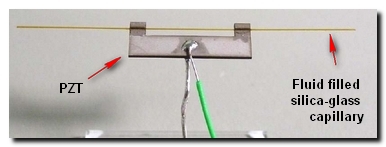 In PZT-glass capillary actuator shown on the right, PZT vibrations can excite vibrational modes of the silica capillary. Depending on the vibrational mode of the capillary acoustical streaming effects and acoustic radiation force fields can be generated inside the capillary. Silica capillary is very cost efficient and is widely used in standard bioanalytical methods. Design of the actuator mechanism enables generation of nonlinear acoustical interactions at battery operatable low voltages enabling particle or biological material manipulation and handling which may enable future portable diagnostic tools.
In PZT-glass capillary actuator shown on the right, PZT vibrations can excite vibrational modes of the silica capillary. Depending on the vibrational mode of the capillary acoustical streaming effects and acoustic radiation force fields can be generated inside the capillary. Silica capillary is very cost efficient and is widely used in standard bioanalytical methods. Design of the actuator mechanism enables generation of nonlinear acoustical interactions at battery operatable low voltages enabling particle or biological material manipulation and handling which may enable future portable diagnostic tools.
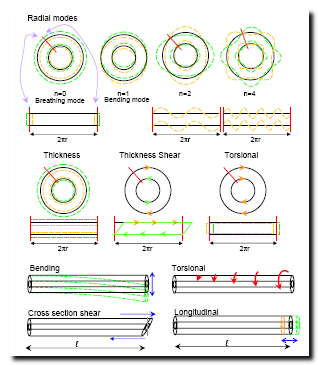
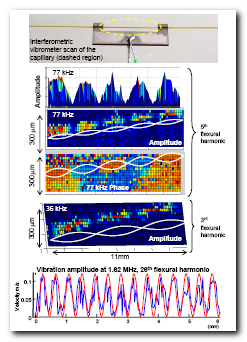 While the device mechanism enables simplicity and cost efficient functionality, challenge comes with the proper modeling of the device. Wave dynamics of a fluid filled thick walled cylinder is nontrivial and an exact solution of the modes through theory of elasticity does not exist. Here we attack problem through particular motion of the wave modes and also utilize computational Finite Element Modeling (in ANSYS). Analytical and computational models we have developed match well with our experimental findings.
While the device mechanism enables simplicity and cost efficient functionality, challenge comes with the proper modeling of the device. Wave dynamics of a fluid filled thick walled cylinder is nontrivial and an exact solution of the modes through theory of elasticity does not exist. Here we attack problem through particular motion of the wave modes and also utilize computational Finite Element Modeling (in ANSYS). Analytical and computational models we have developed match well with our experimental findings.
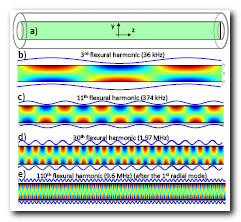
While the interest in subwavalength phenomena in optics is increasing, developments in acoustics are still limited. Through evanescent and nonevanescent fluid structure coupling inside the microcavity we had demonstrated the generation of subwavelength acoustic modes. These modes normally occur inside the microcapillary at 8.26 MHz or higher frequencies. Here in glass capillary actuator, we can generate subwavelength version of same acoustic modes at as low as 30kHz. In other words, standing acoustic modes with acoustic wavelengths in the order of centimeters are generated inside a microcapillary with an internal diameter of 100 micrometers!! This has many advantages... details will be coming in our next publication!.
One particular advantage of the subwavelength modes mentioned above is that, these modes generate periodic acoustic radiation force fields inside the standard capillary even at low voltage drives. Due to subwavelenght behavior many of these modes can be generated at different frequencies. Acoustical radiation forces are not fundamentally limited by pH and salt concentration in contrast to elektrokinetic or magnetic interactions. Since the force field depends on particle size, statistical distribution behaviors are observed with sub 300nm sized particles.
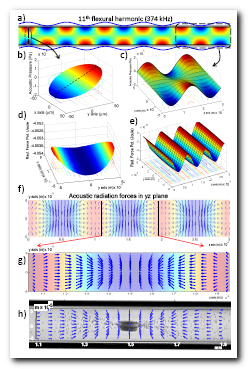


Density Based Separations (right): Direction and the magnitude of acoustic radiation forces depend on the acoustic contrast factor which is a function of the density and the bulk modulus of the materials. Utilizing the variation of the contrast factor for different materials, separation can be achieved by generating acoustical force traps which function as periodic centrifugal fields inside the capillary. Here on the right, silica beads and air bubbles can be separated. With the same principle we had demonstrated separation of human blood cells in raw blood.
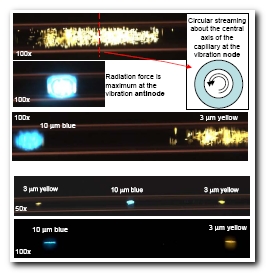
Size Based Separations (left): When boundary vibrations are present, not only acoustic radiation forces but also acoustic streaming effects are observed. While acoustic radiation forces are related to the cube of the particle size, drag force due to the streaming is linearly related to the particle size. Utilizing both streaming and radiation forces we had demonstrated separation of microparticles of same material (polystyrene here) by size.

One powerful aspect of the acoustic radiation forces is that, any material suspended in a fluid will bear a contrast factor naturally. This feature enables collection and separation of biological entities without attaching other materials such as magnetic beads. In addition, acoustic radiation forces are less prone to pH or salt concentration with respect to other methods, especially utilizing, elecrophoretic and electrokinetic interactions.
While in biology high amplitude ultrasonic waves are used to break cell walls and rupture cells, here acoustical amplitudes do not reach to those high levels. Experiments revealed that mammalian cells and bacteria in a microfluidic system can survive while they are collected and brought together with the acoustic radiation forces.
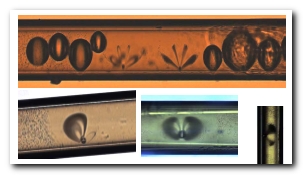
At low frequencies and high amplitudes air bubbles can be generated inside the capillary through a nonlinear phenomenon called cavitation. After these bubbles are generated the frequency can be set to one of their eigenmodes such that bubble starts to oscillate. These surface oscillations generate high velocity streaming jets around the bubble capturing beads in their surrounding.
A new way to monitor and test colloidal stability!
Details of interesting results on this topic are...
coming soon!

A thin capillary attached to the PZT is inserted to a slightly larger capillary filled with fluid sample. Thin capillary attached to the PZT serves as a acoustic wave generator inside the capillary. This actuator mechanism selectively excites the plane wave modes inside the larger capillary which results the Kundt's tube experiment at microscale inside a capillary!
A PZT driven Silicon Nitride microcapillary actuator mechanism is under development. SEM images of the fabricated channels are shown on the left. This novel approach may enable control of subcellular biological components.
All rights reserved, Muhammet Kursad Araz